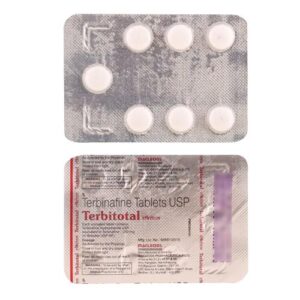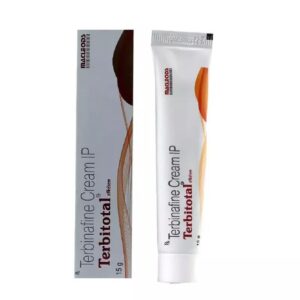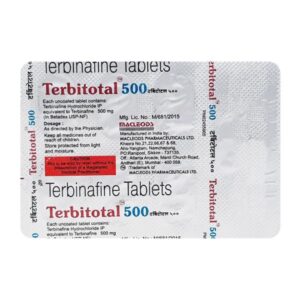TERBINAFINE + HYDROCHLORIDE
Terbinafine: Terbinafine is an antifungal medication commonly used to treat fungal infections of the skin, nails, and scalp. It is classified as an allylamine antifungal agent.
The primary mechanism of action of terbinafine is the inhibition of an enzyme called squalene epoxidase, which is involved in the synthesis of ergosterol, a key component of the fungal cell membrane. By disrupting this process, terbinafine effectively kills the fungal cells and prevents their growth.
For the treatment of fungal skin infections like athlete’s foot (tinea pedis), jock itch (tinea cruris), and ringworm (tinea corporis), terbinafine is typically available as a topical cream or solution. It should be applied directly to the affected area once or twice daily for a recommended duration of 1 to 4 weeks, depending on the specific infection and its severity.
In cases of fungal nail infections (onychomycosis), terbinafine is commonly prescribed in the form of an oral tablet. The usual dose is 250 mg once daily for 6-12 weeks for fingernail infections, and 12-16 weeks for toenail infections. It is important to complete the full course of treatment, as discontinuation prematurely may result in incomplete eradication of the fungal infection.
Common side effects of terbinafine may include gastrointestinal symptoms such as upset stomach, nausea, diarrhea, or abdominal pain. Additionally, some individuals may experience headaches, taste disturbances (e.g., metallic taste), or skin reactions like rash or itching. Serious side effects are rare, but in rare cases, liver toxicity has been reported with terbinafine use. Thus, it is recommended to monitor liver function during treatment, especially for individuals with pre-existing liver disease or those taking other hepatotoxic medications.
It is always advisable to consult a healthcare professional for personalized advice before starting any medication to ensure appropriate dosage, duration, and to consider any potential drug interactions or underlying medical conditions.
Hydrochloride: Hydrochloride is not a specific drug; it is a salt form of chemical compounds that can be found in various medications. However, I can provide you with information on a commonly known drug, such as Oxycodone Hydrochloride.
Oxycodone Hydrochloride is a powerful opioid pain medication used to manage moderate to severe pain. It works by binding to opioid receptors in the brain and spinal cord, blocking pain signals, and producing analgesic effects. It also acts as a central nervous system depressant, reducing feelings of pain and producing a sense of euphoria.
The dose of Oxycodone Hydrochloride varies depending on the severity of the pain and individual response. It is usually prescribed in immediate-release formulations ranging from 5 to 30 mg every 4 to 6 hours as needed for pain relief. Extended-release formulations are available in doses from 10 to 80 mg, which are typically taken every 12 hours for chronic, around-the-clock pain management.
While Oxycodone Hydrochloride can be effective in relieving pain, it carries potential side effects, including:
1. Nausea and vomiting
2. Constipation
3. Drowsiness
4. Dizziness
5. Respiratory depression (uncommon with proper dosage)
6. Itching or skin rash
7. Headache
8. Sweating
9. Decreased blood pressure
10. Urinary retention
It is crucial to use Oxycodone Hydrochloride only as directed by a healthcare professional and to follow the prescribed dose carefully. Misuse or abuse of this medication can lead to addiction, overdose, or even death. If you experience any severe or persistent side effects, it is important to seek medical attention immediately.
It’s important to note that the specific use, mechanism of action, dose, and side effects may vary depending on the specific hydrochloride drug you are asking about.



